For the editing process the main programme we used was Adobe Premiere, however we also used Adobe Audition and Adobe P
hoto shop for smaller tasks such as editing sound clips and editing images. Before we began filming our group created a running order however in the
editing section you may see that this has not been followed at all times. This is because of different complications, for example footage or individual clips being longer or shorter than expected.
We begun editing by capturing our footage we had filmed the weeks before, using our log in sheets to keep track of every but of footage we captured. This was
extremely handy later whilst editing our programme as we found it a lot easier to fill short spaces y simply looking back through the list of shots we had kept. The process of capturing out footage went well however our group did have a few problems in the
beginning; an interview we has filmed with a local police man went missing for a while, which made it difficult to
arrange our footage into a rough order. We also had problems with tapes and had to use a number of different ones in the end in order to keep up to date with deadlines.
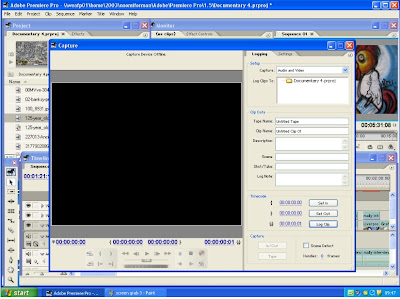
After we captured all of our footage we began to
arrange our programme into
chronological order. We realised at this point that we had to change a big section of our programme, in which had
initially intended to use footage of a graffiti room we had heard of in
Liverpool. We did not however use this footage as the
establishment was not at all what we expected, and the footage we gained whilst in there proved to be either
unusable or of fairly poor quality. Again we had to go through our running order and logging sheets, planning a way to
fill the space. On the
plus side
whilst attempting to get footage at the graffiti room we met a few
graffiti artists who offered to take us a location they knew in which they could spray freely; the footage we gained from this turned out be some of the best we have collected through out our whole production.

One of the more difficult stages throughout the process was the editing off our chroma key interview with the young graffiti artist. Because we were aware how important it was to anchor the subjects meaning and relevant to the programme with mise-en-scene we struggled a little agreeing on a background for our graffiti artist. We had a number of contrasting ideas, for example it was suggested that we use a art room, which would reflect graffiti as an art rather than a crime. However we deliberated and thought that this may seem slightly biased, and we had already agreed we would keep out personal opinion separate from the making of our programme. Therefore we eventual agreed that a chroma key background was the best option. Although we found it simple to cut out the questions we had asked, and cut sections we needed for use, using the green screen key was a lot more hard. We had to apply clips for the background effect and line up every section perfectly in order to keep our interview looking professional which was time consuming, however watching the end process made it worth while, and as i group i think we were all very happy with the effect we had created.
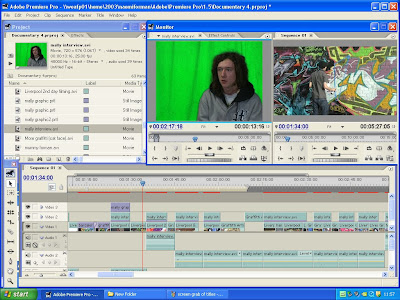
Our group did struggle particularly with the amount of footage we had. Because we had spent whole days at a time filming in different locations we found it easy to create cut aways shots. We used a number of effects on cut away shots, for example the black and white key we added to the graffiti artists spraying an outdoor wall. Although this part of our documentary had gained varying
opinions, we really wanted to created a dramatic atmosphere at this point, as to show the more serious side of graffiti. The slightly sinister
Beethoven music we added helped us to create this.
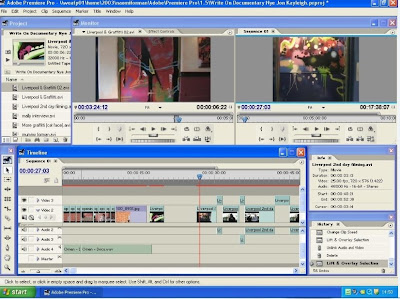
Towards the end off our editing section, once our time line was fully
completed we added final touches to make our programme look more
professional. The main touch we added was the graffics we put in at the interview sections. To keep in line with conventions we used a fair plain but bold font, keeping it simple and clear to read. We also made the name bigger than the interviewee's
occupation, or relevance to the programme; again following the conventions we looked talked of at the
beginning of the course.

Another section we had left to the end of the editing was our opening titles. This does not follow chronological order however we found it difficult at time to agree as a group as we all had quite
individually strong ideas. We agreed
finally on an idea, which i think turned out well. John used a friend to film a few shots of him walking to a brick wall. After we had played around with the order and speed of these shots we displayed a still image that John had took. I then designed a graffiti title on paper and we scanned it in the next day, using Adobe
Photo shop to cut around the edges and make the background transparent.
The final stag of putting our documentary together was adding our voice over and sound to our programme. John picked the perfect song for our opening titles; 'The Writing On The Wall', which not only provided us with a clever word play but also set our programme a fast, upbeat theme.
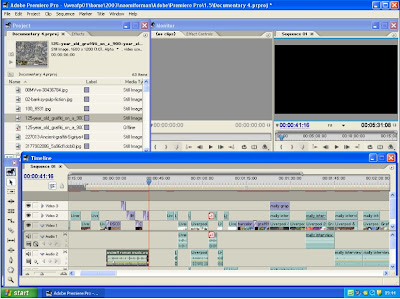
EMAIL TO MUSIC COMPANY
Because we used a quite popular, famous song for our openingtitles (Writing On The Wall - The Prodigy) we had to write an a letter or email to the record company asking for the rights to use this piece of music. Below is a copy of the email i sent The Prodigy's company; Cooking Vinyl UK. The link for Cooking Vinyl's website is also written below.
http://www.cookingvinyl.com/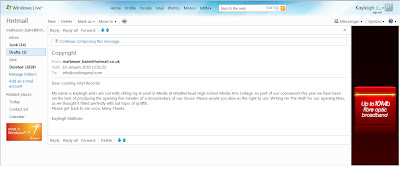
Although at times our group has had many creative differences, i believe we have pulled
together and created a product to the best of our ability. If it were not for all of us having such strong
opinions i think our documentary would not have been what it is today, and in my
opinion together we have created a great opening five
minutes. Although
extremely time consuming, the editing process has been enjoyable and i have learnt a vast range of skills throughout. I now feel a lot more confident using all Adobe programmes, and feel that i could now go on to
individually create the same. However without my group and
teamwork i am sure the final product would not be half as good i this had been an
individual task.


















